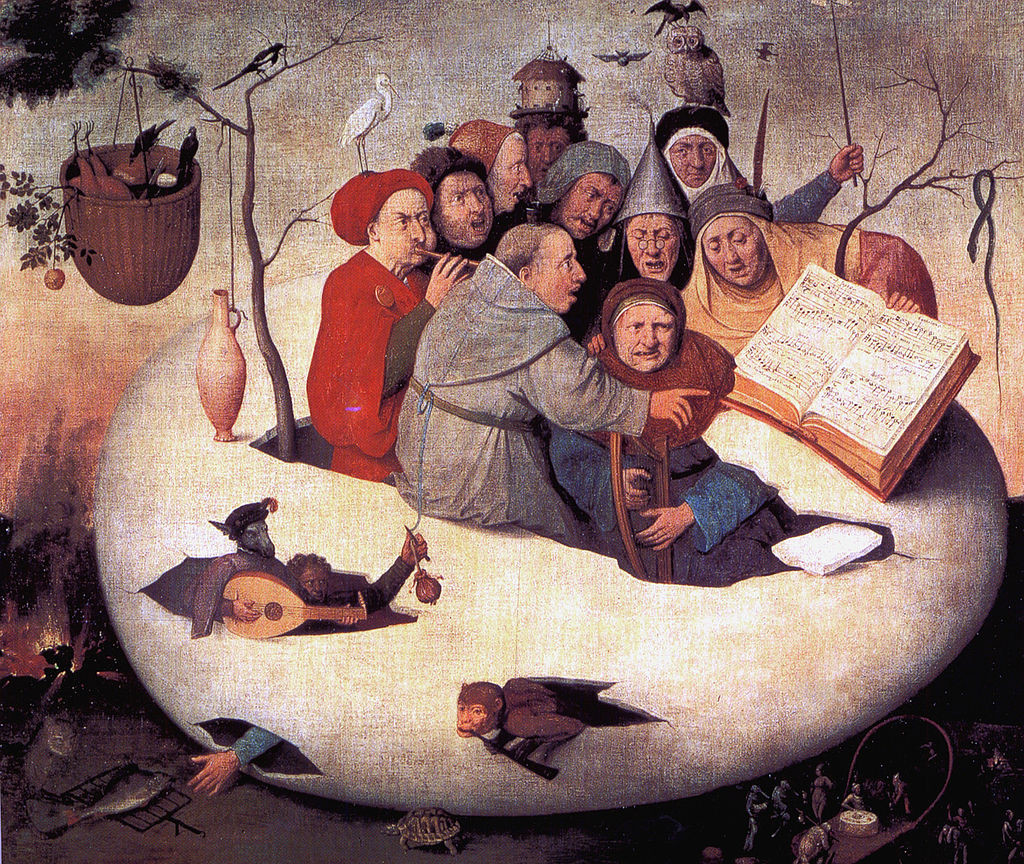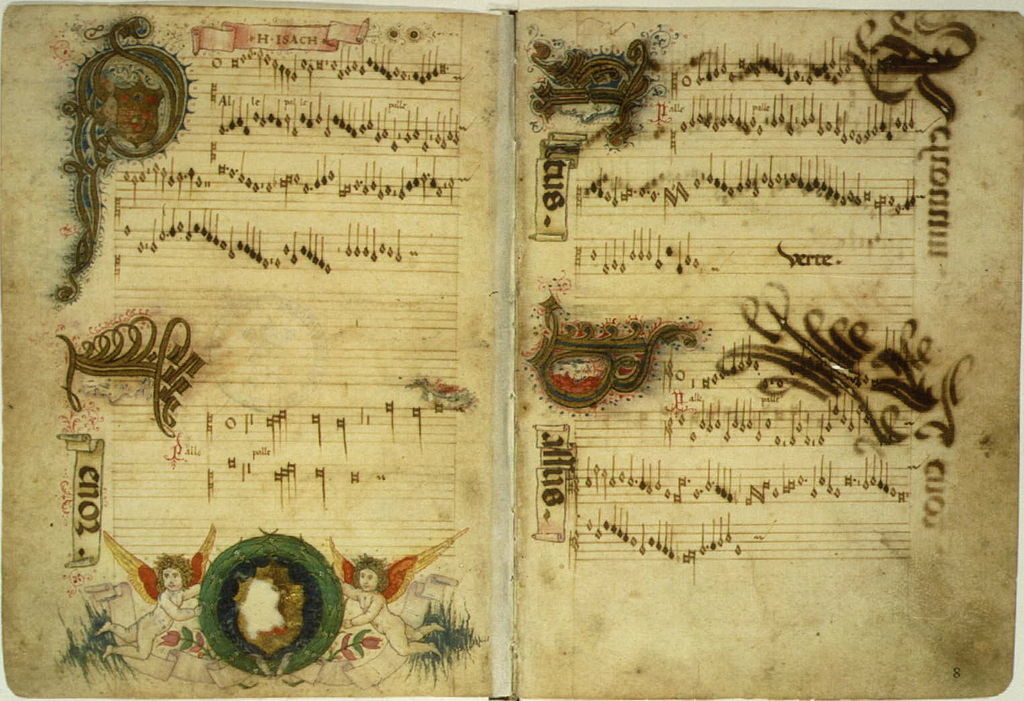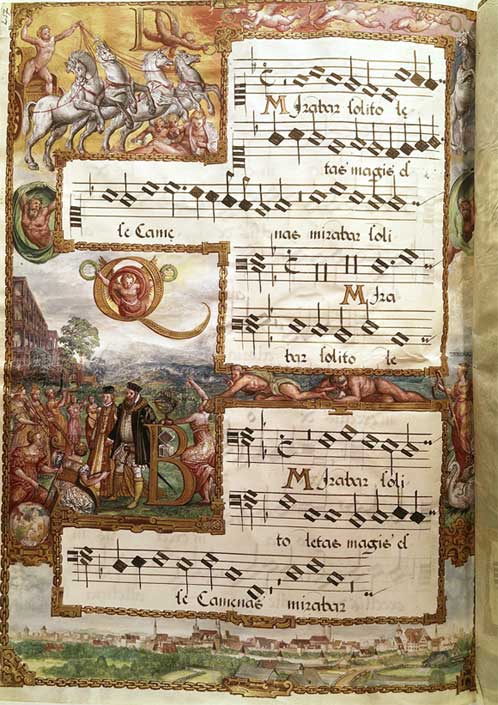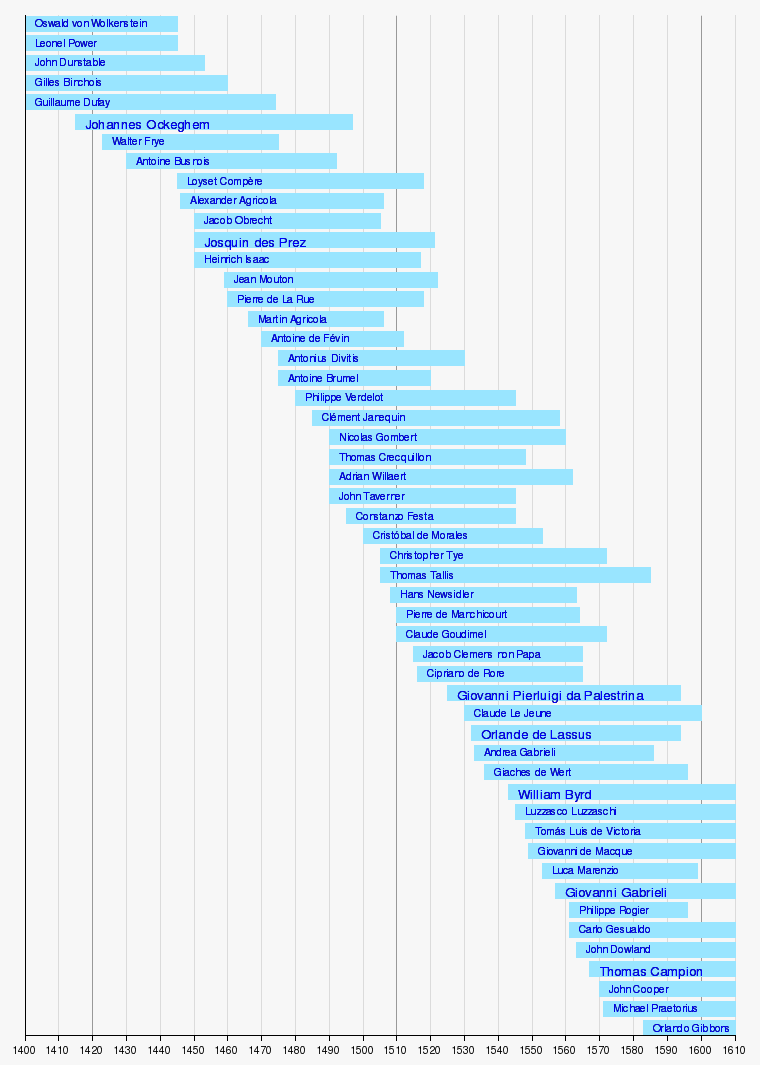9.2: Renaissance Music
- Page ID
- 72409
\( \newcommand{\vecs}[1]{\overset { \scriptstyle \rightharpoonup} {\mathbf{#1}} } \)
\( \newcommand{\vecd}[1]{\overset{-\!-\!\rightharpoonup}{\vphantom{a}\smash {#1}}} \)
\( \newcommand{\dsum}{\displaystyle\sum\limits} \)
\( \newcommand{\dint}{\displaystyle\int\limits} \)
\( \newcommand{\dlim}{\displaystyle\lim\limits} \)
\( \newcommand{\id}{\mathrm{id}}\) \( \newcommand{\Span}{\mathrm{span}}\)
( \newcommand{\kernel}{\mathrm{null}\,}\) \( \newcommand{\range}{\mathrm{range}\,}\)
\( \newcommand{\RealPart}{\mathrm{Re}}\) \( \newcommand{\ImaginaryPart}{\mathrm{Im}}\)
\( \newcommand{\Argument}{\mathrm{Arg}}\) \( \newcommand{\norm}[1]{\| #1 \|}\)
\( \newcommand{\inner}[2]{\langle #1, #2 \rangle}\)
\( \newcommand{\Span}{\mathrm{span}}\)
\( \newcommand{\id}{\mathrm{id}}\)
\( \newcommand{\Span}{\mathrm{span}}\)
\( \newcommand{\kernel}{\mathrm{null}\,}\)
\( \newcommand{\range}{\mathrm{range}\,}\)
\( \newcommand{\RealPart}{\mathrm{Re}}\)
\( \newcommand{\ImaginaryPart}{\mathrm{Im}}\)
\( \newcommand{\Argument}{\mathrm{Arg}}\)
\( \newcommand{\norm}[1]{\| #1 \|}\)
\( \newcommand{\inner}[2]{\langle #1, #2 \rangle}\)
\( \newcommand{\Span}{\mathrm{span}}\) \( \newcommand{\AA}{\unicode[.8,0]{x212B}}\)
\( \newcommand{\vectorA}[1]{\vec{#1}} % arrow\)
\( \newcommand{\vectorAt}[1]{\vec{\text{#1}}} % arrow\)
\( \newcommand{\vectorB}[1]{\overset { \scriptstyle \rightharpoonup} {\mathbf{#1}} } \)
\( \newcommand{\vectorC}[1]{\textbf{#1}} \)
\( \newcommand{\vectorD}[1]{\overrightarrow{#1}} \)
\( \newcommand{\vectorDt}[1]{\overrightarrow{\text{#1}}} \)
\( \newcommand{\vectE}[1]{\overset{-\!-\!\rightharpoonup}{\vphantom{a}\smash{\mathbf {#1}}}} \)
\( \newcommand{\vecs}[1]{\overset { \scriptstyle \rightharpoonup} {\mathbf{#1}} } \)
\( \newcommand{\vecd}[1]{\overset{-\!-\!\rightharpoonup}{\vphantom{a}\smash {#1}}} \)
\(\newcommand{\avec}{\mathbf a}\) \(\newcommand{\bvec}{\mathbf b}\) \(\newcommand{\cvec}{\mathbf c}\) \(\newcommand{\dvec}{\mathbf d}\) \(\newcommand{\dtil}{\widetilde{\mathbf d}}\) \(\newcommand{\evec}{\mathbf e}\) \(\newcommand{\fvec}{\mathbf f}\) \(\newcommand{\nvec}{\mathbf n}\) \(\newcommand{\pvec}{\mathbf p}\) \(\newcommand{\qvec}{\mathbf q}\) \(\newcommand{\svec}{\mathbf s}\) \(\newcommand{\tvec}{\mathbf t}\) \(\newcommand{\uvec}{\mathbf u}\) \(\newcommand{\vvec}{\mathbf v}\) \(\newcommand{\wvec}{\mathbf w}\) \(\newcommand{\xvec}{\mathbf x}\) \(\newcommand{\yvec}{\mathbf y}\) \(\newcommand{\zvec}{\mathbf z}\) \(\newcommand{\rvec}{\mathbf r}\) \(\newcommand{\mvec}{\mathbf m}\) \(\newcommand{\zerovec}{\mathbf 0}\) \(\newcommand{\onevec}{\mathbf 1}\) \(\newcommand{\real}{\mathbb R}\) \(\newcommand{\twovec}[2]{\left[\begin{array}{r}#1 \\ #2 \end{array}\right]}\) \(\newcommand{\ctwovec}[2]{\left[\begin{array}{c}#1 \\ #2 \end{array}\right]}\) \(\newcommand{\threevec}[3]{\left[\begin{array}{r}#1 \\ #2 \\ #3 \end{array}\right]}\) \(\newcommand{\cthreevec}[3]{\left[\begin{array}{c}#1 \\ #2 \\ #3 \end{array}\right]}\) \(\newcommand{\fourvec}[4]{\left[\begin{array}{r}#1 \\ #2 \\ #3 \\ #4 \end{array}\right]}\) \(\newcommand{\cfourvec}[4]{\left[\begin{array}{c}#1 \\ #2 \\ #3 \\ #4 \end{array}\right]}\) \(\newcommand{\fivevec}[5]{\left[\begin{array}{r}#1 \\ #2 \\ #3 \\ #4 \\ #5 \\ \end{array}\right]}\) \(\newcommand{\cfivevec}[5]{\left[\begin{array}{c}#1 \\ #2 \\ #3 \\ #4 \\ #5 \\ \end{array}\right]}\) \(\newcommand{\mattwo}[4]{\left[\begin{array}{rr}#1 \amp #2 \\ #3 \amp #4 \\ \end{array}\right]}\) \(\newcommand{\laspan}[1]{\text{Span}\{#1\}}\) \(\newcommand{\bcal}{\cal B}\) \(\newcommand{\ccal}{\cal C}\) \(\newcommand{\scal}{\cal S}\) \(\newcommand{\wcal}{\cal W}\) \(\newcommand{\ecal}{\cal E}\) \(\newcommand{\coords}[2]{\left\{#1\right\}_{#2}}\) \(\newcommand{\gray}[1]{\color{gray}{#1}}\) \(\newcommand{\lgray}[1]{\color{lightgray}{#1}}\) \(\newcommand{\rank}{\operatorname{rank}}\) \(\newcommand{\row}{\text{Row}}\) \(\newcommand{\col}{\text{Col}}\) \(\renewcommand{\row}{\text{Row}}\) \(\newcommand{\nul}{\text{Nul}}\) \(\newcommand{\var}{\text{Var}}\) \(\newcommand{\corr}{\text{corr}}\) \(\newcommand{\len}[1]{\left|#1\right|}\) \(\newcommand{\bbar}{\overline{\bvec}}\) \(\newcommand{\bhat}{\widehat{\bvec}}\) \(\newcommand{\bperp}{\bvec^\perp}\) \(\newcommand{\xhat}{\widehat{\xvec}}\) \(\newcommand{\vhat}{\widehat{\vvec}}\) \(\newcommand{\uhat}{\widehat{\uvec}}\) \(\newcommand{\what}{\widehat{\wvec}}\) \(\newcommand{\Sighat}{\widehat{\Sigma}}\) \(\newcommand{\lt}{<}\) \(\newcommand{\gt}{>}\) \(\newcommand{\amp}{&}\) \(\definecolor{fillinmathshade}{gray}{0.9}\)Introduction
Renaissance music is music written in Europe during the Renaissance. Consensus among music historians–with notable dissent–has been to start the era around 1400, with the end of the medieval era, and to close it around 1600, with the beginning of the baroque period, therefore commencing the musical Renaissance about a hundred years after the beginning of the Renaissance as understood in other disciplines. As in the other arts, the music of the period was significantly influenced by the developments which define the early modern period: the rise of humanistic thought; the recovery of the literary and artistic heritage of ancient Greece and Rome; increased innovation and discovery; the growth of commercial enterprise; the rise of a bourgeois class; and the Protestant Reformation. From this changing society emerged a common, unifying musical language, in particular the polyphonic style of the Franco-Flemish school.

The invention of the Gutenberg press made distribution of music and musical theory possible on a wide scale. Demand for music as entertainment and as an activity for educated amateurs increased with the emergence of a bourgeois class. Dissemination of chansons, motets, and masses throughout Europe coincided with the unification of polyphonic practice into the fluid style which culminated in the second half of the sixteenth century in the work of composers such as Palestrina, Lassus, Victoria and William Byrd. Relative political stability and prosperity in the Low Countries, along with a flourishing system of music education in the area’s many churches and cathedrals, allowed the training of hundreds of singers and composers. These musicians were highly sought throughout Europe, particularly in Italy, where churches and aristocratic courts hired them as composers and teachers. By the end of the sixteenth century, Italy had absorbed the northern influences, with Venice, Rome, and other cities being centers of musical activity, reversing the situation from a hundred years earlier. Opera arose at this time in Florence as a deliberate attempt to resurrect the music of ancient Greece.
Music, increasingly freed from medieval constraints, in range, rhythm, harmony, form, and notation, became a vehicle for new personal expression. Composers found ways to make music expressive of the texts they were setting. Secular music absorbed techniques from sacred music, and vice versa. Popular secular forms such as the chanson and madrigal spread throughout Europe. Courts employed virtuoso performers, both singers and instrumentalists. Music also became more self-sufficient with its availability in printed form, existing for its own sake. Many familiar modern instruments (including the violin, guitar, lute and keyboard instruments), developed into new forms during the Renaissance responding to the evolution of musical ideas, presenting further possibilities for composers and musicians to explore. Modern woodwind and brass instruments like the bassoon and trombone also appeared; extending the range of sonic color and power. During the fifteenth century the sound of full triads became common, and towards the end of the sixteenth-century the system of church modes began to break down entirely, giving way to the functional tonality which was to dominate western art music for the next three centuries.

From the Renaissance era both secular and sacred music survives in quantity, and both vocal and instrumental. An enormous diversity of musical styles and genres flourished during the Renaissance, and can be heard on commercial recordings in the twenty-first century, including masses, motets, madrigals, chansons, accompanied songs, instrumental dances, and many others. Numerous early music ensembles specializing in music of the period give concert tours and make recordings, using a wide range of interpretive styles.
One of the most pronounced features of early Renaissance European art music was the increasing reliance on the interval of the third (in the Middle Ages, thirds had been considered dissonances). Polyphony became increasingly elaborate throughout the fourteenth century, with highly independent voices: the beginning of the fifteenth century showed simplification, with the voices often striving for smoothness. This was possible because of a greatly increased vocal range in music–in the Middle Ages, the narrow range made necessary frequent crossing of parts, thus requiring a greater contrast between them.
The modal (as opposed to tonal) characteristics of Renaissance music began to break down towards the end of the period with the increased use of root motions of fifths. This later developed into one of the defining characteristics of tonality.
The main characteristics of Renaissance music are the following:
- Music based on modes
- Richer texture in four or more parts
- Blending rather than contrasting strands in the musical texture
- Harmony with a greater concern with the flow and progression of chords
Polyphony is one of the notable changes that mark the Renaissance from the Middle Ages musically. Its use encouraged the use of larger ensembles and demanded sets of instruments that would blend together across the whole vocal range.
Principal liturgical forms which endured throughout the entire Renaissance period were masses and motets, with some other developments towards the end, especially as composers of sacred music began to adopt secular forms (such as the madrigal) for their own designs.
Common sacred genres were the mass, the motet, the madrigale spirituale, and the laude.

During the period, secular music had an increasing distribution, with a wide variety of forms, but one must be cautious about assuming an explosion in variety: since printing made music more widely available, much more has survived from this era than from the preceding medieval era, and probably a rich store of popular music of the late Middle Ages is irretrievably lost.
Secular music was music that was independent of churches. The main types were the German Lied, Italian frottola, the French chanson, the Italian madrigal, and the Spanish villancico. Other secular vocal genres included the caccia, rondeau, virelai, bergerette, ballade, musique mesurée, canzonetta, villanella, villotta, and the lute song. Mixed forms such as the motet-chanson and the secular motet also appeared.
Purely instrumental music included consort music for recorder or viol and other instruments, and dances for various ensembles. Common instrumental genres were the toccata, prelude, ricercar, and canzona. Dances played by Instrumental ensembles included the basse danse, tourdion, saltarello, pavane, galliard, allemande, courante, bransle, canarie, and lavolta. Music of many genres could be arranged for a solo instrument such as the lute, vihuela, harp, or keyboard. Such arrangements were called intabulations.
Towards the end of the period, the early dramatic precursors of opera such as monody, the madrigal comedy, and the intermedio are seen.
Theory and Notation
According to Margaret Bent, “Renaissance notation is underprescriptive by our standards; when translated into modern form it acquires a prescriptive weight that overspecifies and distorts its original openness.”

Renaissance compositions were notated only in individual parts; scores were extremely rare, and bar lines were not used. Note values were generally larger than are in use today; the primary unit of beat was the semibreve, or whole note. As had been the case since the Ars Nova, there could be either two or three of these for each breve (a double-whole note), which may be looked on as equivalent to the modern “measure,” though it was itself a note value and a measure is not. The situation can be considered this way: it is the same as the rule by which in modern music a quarter-note may equal either two eighth-notes or three, which would be written as a “triplet.” By the same reckoning, there could be two or three of the next smallest note, the “minim,” (equivalent to the modern “half note”) to each semibreve.
These different permutations were called “perfect/imperfect tempus” at the level of the breve–semibreve relationship, “perfect/imperfect prolation” at the level of the semibreve–minim, and existed in all possible combinations with each other. Three-to-one was called “perfect,” and two-to-one “imperfect.” Rules existed also whereby single notes could be halved or doubled in value (“imperfected” or “altered,” respectively) when preceded or followed by other certain notes. Notes with black noteheads (such as quarter notes) occurred less often. This development of white mensural notation may be a result of the increased use of paper (rather than vellum), as the weaker paper was less able to withstand the scratching required to fill in solid noteheads; notation of previous times, written on vellum, had been black. Other colors, and later, filled-in notes, were used routinely as well, mainly to enforce the aforementioned imperfections or alterations and to call for other temporary rhythmical changes.
Accidentals were not always specified, somewhat as in certain fingering notations (tablatures) today. However, Renaissance musicians would have been highly trained in dyadic counterpoint and thus possessed this and other information necessary to read a score, “what modern notation requires [accidentals] would then have been perfectly apparent without notation to a singer versed in counterpoint.” A singer would interpret his or her part by figuring cadential formulas with other parts in mind, and when singing together musicians would avoid parallel octaves and fifths or alter their cadential parts in light of decisions by other musicians.
It is through contemporary tablatures for various plucked instruments that we have gained much information about what accidentals were performed by the original practitioners.
For information on specific theorists, see Johannes Tinctoris, Franchinus Gaffurius, Heinrich Glarean, Pietro Aron, Nicola Vicentino, Tomás de Santa María, Gioseffo Zarlino, Vicente Lusitano, Vincenzo Galilei, Giovanni Artusi, Johannes Nucius, and Pietro Cerone.
Time Line of Renaissance Composers

Contributors and Attributions
- Renaissance music. Provided by: Wikipeida. Located at: https://en.Wikipedia.org/wiki/Renaissance_music. License: CC BY-SA: Attribution-ShareAlike
- Concert in an Egg. Provided by: Wikimedia. Located at: https://commons.wikimedia.org/wiki/File:Concert_in_the_Egg.jpg. License: Public Domain: No Known Copyright
- Chansonnier by Heinrich Isaac. Provided by: Wikimedia. Located at: https://commons.wikimedia.org/wiki/File:Isaac_pallepalle.jpg. License: Public Domain: No Known Copyright
- Cyprien de Rore manuscript. Provided by: Wikimedia. Located at: https://commons.wikimedia.org/wiki/File:Hans_Mielich_-_Cyprien_de_Rore.jpg. License: Public Domain: No Known Copyright


